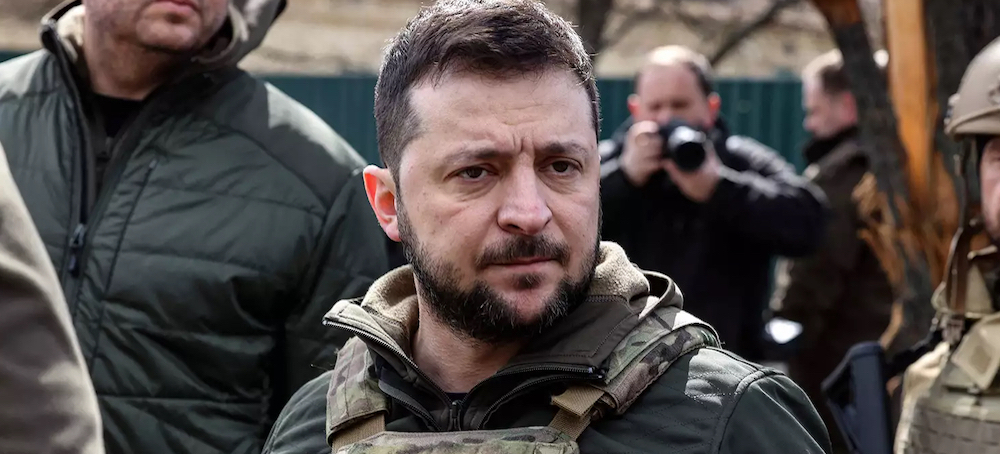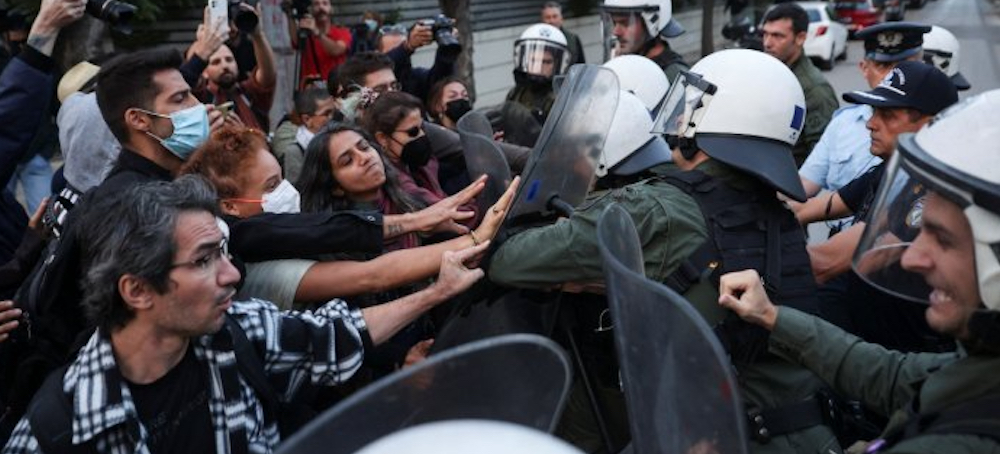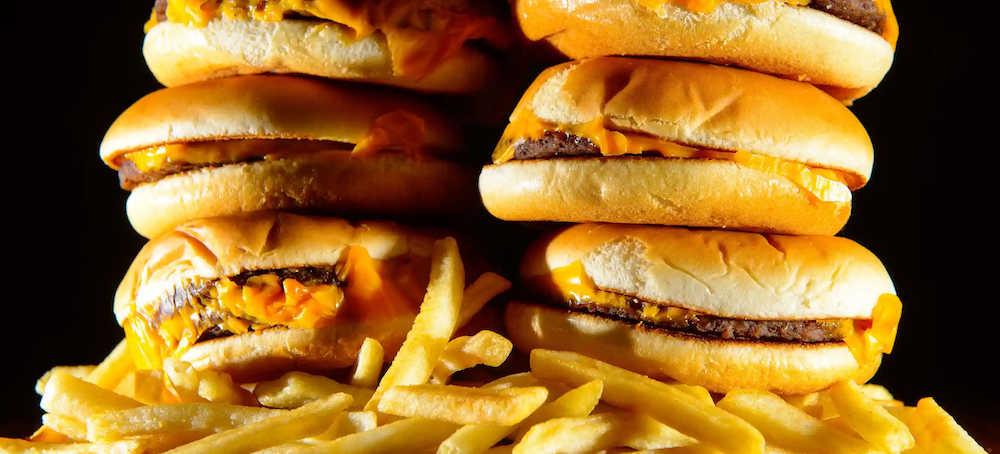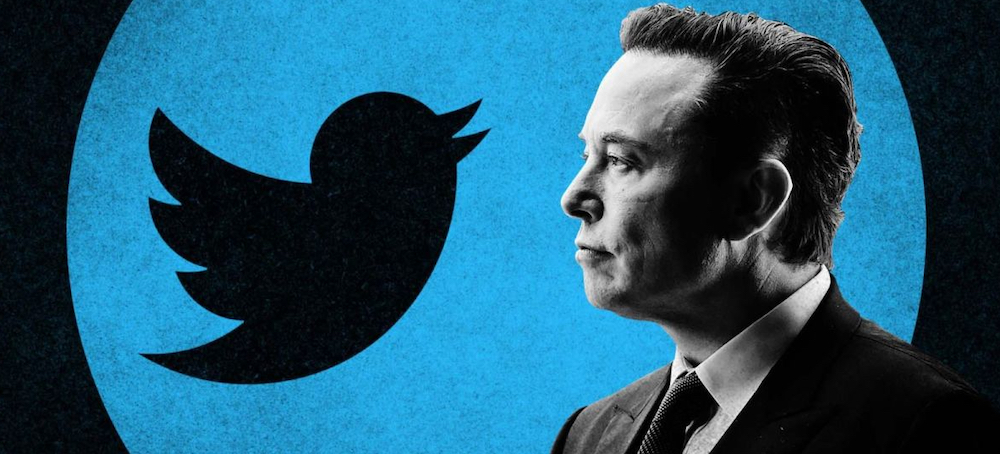Live on the homepage now!
Reader Supported News
It is our fervent hope that the results of this past week portend an America returning to sanity, steadiness, and optimism. We recognize that the battle for the soul of this nation remains unresolved, as indeed it has for the entirety of our history. But there also is a flame of progress and possibility that cannot be extinguished.
America, for all its faults, is a beautiful place. We can think of few artists and songs better suited for this moment than the incomparable Ray Charles and his rendition of “America the Beautiful.”
With gratitude to all of you in the Steady community, who also grant us a reason to smile.
READ MORE Ukainian President Volodymyr Zelensky. (photo: Ronaldo Schemidt/Getty Images)
Ukainian President Volodymyr Zelensky. (photo: Ronaldo Schemidt/Getty Images)
People take stock after Ukrainian soldiers liberate city from forces that aimed to make them ‘suffer as much as possible’
On Sunday, President Volodymyr Zelenskiy accused Russian soldiers of war crimes and killing civilians in Kherson. “Investigators have already documented more than 400 Russian war crimes. Bodies of dead civilians and servicemen have been found. The Russian army left behind the same savagery it did in other regions of the country it entered,” he said.
He also said Russian forces had destroyed key infrastructure before retreating, while the mayor of Kherson said the humanitarian situation was “severe” because of a lack of medicine and bread.
Thousands of mines, tripwires and unexploded shells have been left by the troops.
Roman Golovnya, an adviser to the city’s local administration, said: “Russian occupying forces and collaborators did everything possible to make those people who remained in the city suffer as much as possible during these days, weeks and months of waiting.”
The retreating Russians comprehensively destroyed all critical infrastructure including communications, electricity, water, heat, a 100-metre-tall TV tower and at least four bridges.
The Ukrainian authorities are trying to assess the damage to the Nova Kakhovka dam, on the Dnipro River, about 40 miles to the north-east, which the Russians attempted to blow up during their withdrawal. Satellite images show signs of destruction “with sections of the dam and sluice gates destroyed”. However, it is not clear if the structural integrity of the reservoir is at risk. With a water volume of 18.2 cubic km, if destroyed the Kakhovka reservoir could flood a huge area, including the city of Kherson.
People have testified that Russian troops carried out rampant looting in the city, stealing private cars, washing machines, microwaves, women’s clothes and other household goods. They removed 15,000 exhibits from Kherson’s art museum and stole the bones of Grigory Potemkin, Catherine the Great’s friend and lover, from a crypt in the city’s cathedral.
On Sunday it emerged they had also taken most of the animals from Kherson’s zoo. Llamas, wolves, donkeys, racoons and squirrels were all shipped to Crimea. “The zoo’s racoon was stolen not by some stupid soldier but by the Russian command,” said Oleksandr Todorchuk, the head of UAnimals, which rescues animals in war.
Ukrainians accused Russians of blowing up dozens of schools across the province, further damaging the prospects of children who have already missed nine months of lessons. In the occupied village of Mala Oleksandrivka, Russian soldiers converted the local school into a military base and parked their tanks next to the sports field. In Mylove – liberated on Thursday – they blew up the main school and nursery as they rolled out in armoured vehicles. About 300 people stayed in the village during the occupation, including teenagers and children of primary school age. They waved at visiting cars and smiled.
“Our kids have had no education since 24 February,” said Serhii Melnikov, a local resident. With little or no internet, it had been difficult for students to access online education, he said, adding that the village was without power, water and gas, a situation typical across the rural Kherson area.
Utility companies on Sunday said they were working flat out to restore connections. They said it would take at least a month before electricity could be restored to the city of Kherson. In some of the region’s northern communities closest to the former frontline, power may be restored as early as next week, they said.
However, Iryna, a resident from Kherson city, said in a Telegram channel that the hope that light and water would be restored in a short time remained distant. “The guys are already doing a lot, but we need to look reality in the eyes,” she added. “The electricity today, tomorrow and even the day after tomorrow will not appear … everything will be later, we just need to be patient and wait.”
Yulianna, another resident from Kherson, said: “The war is still going on in the country and in our city. We had been waiting for eight months, we can wait for more weeks. The most important thing is that the city has been liberated.”
As has already happened in other Ukrainian regions occupied by the Russians at the start of their invasion, the first move of the Moscow troops was to destroy the telecommunication towers. For nearly eight months, the people of Kherson have been cut off from the world, from time and space. The lack of telephone networks has meant no more contact with the outside world. On Saturday, a wifi hotspot was set up next to the main bus station using a satellite dish, with passersby able to log on.
Some have already started gathering wood in preparation for a cold and bleak winter.
According to US officials, the Kremlin’s decision to pull out of Kherson was based in part on concerns that its soldiers would “be cut off from supplies as winter set in”.
Additional security measures were being carried out, as military police checked the documents of local people and hunted for Russian soldiers and saboteurs who might have disguised themselves as civilians. The regional governor, Yaroslav Yanushevych, said the authorities would maintain a curfew from 5pm to 8am and ban people from entering or leaving the city.
“The enemy mined all critical infrastructure objects. We are trying to meet within a few days and [then] open the city,” he told Ukrainian TV, adding that mobile phone operations could start working on Sunday.
Mines left behind by Russian forces are becoming one of Ukraine’s biggest challenges, especially as it rushes to clean up and restore the ruins. According to Kyiv, more than 2,000 explosive items from booby traps to mines have already been removed.
In Kharkiv region, two roadworkers were killed and four injured by a mine while trying to re-tarmac the road in a formerly occupied area.
Zelenskiy said the Ukrainian army’s spectacular counteroffensive would continue.
“We will definitely reach our state border – all sections of the internationally recognised border of Ukraine,” Zelesnkiy said. He promised the de-occupation of the southern cities of Henichesk – named by Russia as its new administrative “capital” for the Kherson region – and Melitopol.
His statement suggests Crimea – illegally annexed by Moscow in 2014 – is an active Ukrainian military target.
READ MORE Demonstrators scuffle with riot police, during a protest following the death of Mahsa Amini. (photo: Reuters)
Demonstrators scuffle with riot police, during a protest following the death of Mahsa Amini. (photo: Reuters)
Iran on Sunday issued its first death sentence linked to participation in "riots", amid nationwide protests since the death of Mahsa Amini, the judiciary's Mizan Online website said.
Another court in Tehran sentenced five others to prison terms of between five to 10 years for "gathering and conspiring to commit crimes against national security and disturbing public order".
All those convicted can appeal their sentence, Mizan added.
Dozens of people, mainly demonstrators but also security personnel, have been killed during the protests, which the authorities have branded as "riots".
Earlier on Sunday, the judiciary said it had charged more than 750 people in three provinces for involvement in such incidents.
More than 2,000 people had already been charged, nearly half of them in the capital Tehran, since the demonstrations began in mid-September, according to judiciary figures.
Judicial chief for the southern province of Hormozgan, Mojtaba Ghahremani, said 164 people had been charged "after the recent riots", Mizan Online ealier said.
They face accusations including "incitement to killing", "harming security forces", "propaganda against the regime" and "damaging public property", the website said, adding that their trials would begin "from Thursday in the presence of their lawyers".
Another 276 people were charged in the central province of Markazi, its judiciary chief Abdol-Mehdi Mousavi was quoted as saying by state news agency IRNA.
However, 100 young people were released after signing pledges not to participate in any future "riots", IRNA said.
In central Isfahan province, judicial chief Asadollah Jafari said 316 cases had been filed in connection with the recent strife.
Twelve have already gone to trial, the Tasnim news agency reported him as saying late Saturday.
Amini's death on September 16 came days after her arrest by the morality police for an alleged breach of the country's strict dress rules for women.
Authorities have denied claims by rights groups abroad that about 15,000 people have been detained in the ensuing unrest.
Iran on Sunday criticised a Friday meeting between French president Emmanuel Macron and opponents of the Islamic republic, calling Emmanuel Macron's comments after the encounter "regrettable and shameful".
Macron met with four prominent Iranian dissidents, all of them women.
 Targeted junk food ads exacerbate existing inequalities, according to a new study. (photo: Dominic Lipinski/PA)
Targeted junk food ads exacerbate existing inequalities, according to a new study. (photo: Dominic Lipinski/PA)
Advertising for fatty, salty and sugary food and drink is disproportionately aimed at Black and Hispanic children, teens and adults, a new study finds
“You’ll see these ads pop up for sugary expensive cereals, to entice the kids to pressure their parents to purchase these foods, and then you as the parent look like the bad guy because you’re not buying them,” Filemon says.
The nutritionist, whose children range from nine months to 11 years old, steadfastly blocks mobile game and internet ads so they aren’t exposed to junk food messaging at home. Still, the barrage is constant, says Filemon, who posts about parenting and nutrition on Instagram. They are on TV, YouTube, social media platforms, game-streaming apps and even mobile educational games.
“Some parents may not even know that blocking the ads is a possibility, and their kids are watching those ads all the time,” she says. Filemon, who is Black, specifically worries about families of color, who she says are being systematically targeted with ads for unhealthy foods.
Her concerns are supported by a slew of research.
A new study published in November by the Rudd Center for Food and Policy Health at the University of Connecticut found that US food companies disproportionately market unhealthy food and drink – including candy, sodas, snacks and fast food – to Black and Hispanic children, teens and adults.
In 2021, Black youth and adults viewed up to 21% more food and beverage commercials than their white peers, according to the report, which also found food companies increased their advertising spend on Spanish language TV as a total proportion of their TV ad budget.
The study’s findings build on research that goes back more than a decade. In 2010, Rudd Center researchers found an increase in fast-food adverts geared towards children and they found Black children were exposed to 50% more fast-food ads than their white peers. A 2014 Arizona State University report revealed fast-food restaurants in predominantly Black neighborhoods were more likely to target advertising to children – including displaying kids meal toys and using cartoon characters.
As the advertising landscape changes, companies are finding creative ways to market their products. Many fast-food brands employ celebrities from Black and Hispanic communities, which can encourage young people of color to purchase their products, according to the Rudd Center report. McDonald’s, for example, has partnered with rappers Saweetie and Travis Scott.
“When I looked into the McDonald’s meals that are sponsored and endorsed by celebrities, you almost always see a person of color with that meal,” said Rahanna Bisseret Martinez, 18, a Top Chef Junior finalist who grew up in a Haitian-American and Mexican-American household. “Instead, I’d love to see celebrities really being in their community and supporting people that way … If someone tells me a pop star is giving out organic fruit rolls on a corner in the city, I would be there, especially as a kid.”
A spokesperson for McDonald’s said that the company “believes in marketing responsibly and ensuring our advertising reflects the diverse customers and communities we serve”. The fast-food giant is “helping lead the industry on self-regulation around advertising to children” the spokesperson added, including “balanced menu offerings and responsible marketing to kids under age 12”.
The success of targeted advertising exacerbates existing inequalities around diet and diet-related diseases in Black and Hispanic communities, the recent Rudd Center report concludes.
While nearly one in five children in the US is categorized as obese, rates are higher among children of color: 26.2% of Hispanic children and 24.8% of Black children are classified as obese, compared to 16.6% of white children.
Children of color are more likely to live in areas lacking affordable, nutritious food. Predominantly white neighborhoods have a higher percentage of supermarkets than predominantly Black neighborhoods, while grocery stores in some low-income communities of color are less likely to stock healthy foods than stores in higher-income, predominantly white areas.
“For many in the Black and brown communities, it’s hard to get out of this systemic food depression,” Filemon says. “Not everyone has the financial means to do all the steps required to eat healthy.” Yet despite significant socioeconomic challenges to healthier eating, parents are often blamed for their children’s obesity.
Campaigners are calling for structural changes to dilute the power of big food companies but so far federal action has been limited.
In the late 1970s, an attempt by the Federal Trade Commission (FTC) to crack down on advertising to children ended in disaster. A proposed ban on TV ads for junk food aimed at children caused an uproar, not only among the food industry but also politicians. Congress allowed the commission’s funding to lapse and the agency was closed for a short time.
Since then, powerful food industry lobbying has worked to prevent the FTC from enacting even voluntary guidelines. In 2011, the organization dropped plans for guidelines banning junk food ads to children 17 and under, instead lowering the age limit to 11, after being pressured by food industry and media giants, who spent tens of millions lobbying against the voluntary standards.
In a 2012 report, the FTC said that while there was “legitimate cause for public concern” around ads targeted at children, a ban would be “neither a workable nor an efficacious solution to the health problem of childhood obesity”.
Mitchell J Katz, senior public affairs specialist at the FTC, told the Guardian: “The commission does not regulate advertising. We enforce the FTC Act, which prohibits deceptive or misleading advertising.”
Policies are being proposed at more local levels. In New York state, the Predatory Marketing Prevention Act (PMPA), a bill that would categorize unhealthy food marketed to children as misleading or deceptive and allow regulators to restrict this kind of advertising, is in review with the New York senate’s health committee.
There are also efforts at corporate self-regulation. The Children’s Food and Beverage Advertising Initiative was set up to create guidelines around advertising and has 19 food and drinks companies as members. They have pledged to restrict advertising of unhealthy products to children under 12, although the guidelines are littered with loopholes, according to a Rudd Center analysis.
Some media companies have implemented their own guidelines. Disney restricts food advertisements across its television channels, radio station and website to food products that meet its nutrition criteria for limiting calories and reducing saturated fat, sodium and sugar.
YouTube Kids has a policy prohibiting paid food and beverage advertising but YouTube creators are able to use paid product placement or incentivized endorsements, as long as they disclose them. When it comes to food, these products tend to be unhealthy. An 2020 analysis of 179 videos from five of the most-watched child YouTube influencers found more than 90% of the food and beverage mentions were unhealthy branded items.
A spokesperson for Google, which owns YouTube, said: “On YouTube Kids, Made for Kids content and Supervised Experiences on YouTube we do not allow ads for foods and beverages products nor are creators allowed to make money promoting these products. Creators that include paid promotions in their videos are responsible for complying with ads policies and declaring whether they are receiving money for promoting products generally.”
Social media advertising can be particularly hard to manage because parents don’t see these platforms as a way for children to receive marketing, said Frances Fleming-Millici, director of marketing initiatives for the Rudd Center. “It’s not advertising in a way that we are programmed to think of. Branded products in child influencer videos are hard for parents to do anything about.”
The FTC held an event in October to review these types of advertising, sometimes called “stealth marketing” or “blurred advertising”. Panelists suggested potential solutions including disclosures, parental controls and even a ban on stealth marketing aimed at children.
There is much more companies can be doing, Fleming-Millici said, including making deeper investments in marginalized communities. “If you are saying you care about these communities or about increasing equity in racial justice, then look at what you’re marketing and making for communities of color, because it’s actually hurting these communities,” she said.
In July, the Council on Black Health (CBH), a research and action network, launched an initiative calling for the availability and promotion of healthier food choices in Black communities.
Shiriki K Kumanyika, chair of the CBH, said change will come by keeping the pressure on fast food and packaged food corporations, rather than pointing fingers at individuals. “I don’t believe [junk food] is all consumers want, and this is not an isolated problem that you can fix at the consumer interface.”
Filemon says fast-food companies must increase their advertising of healthier items, making them more attractive to kids. “They can still make money by advertising their more nutrient-dense foods,” she said. “The constant marketing of unhealthy food is setting these kids of color and their bodies – the future of their health – up for failure.”
Follow us on facebook and twitter!
PO Box 2043 / Citrus Heights, CA 95611




No comments:
Post a Comment
Note: Only a member of this blog may post a comment.